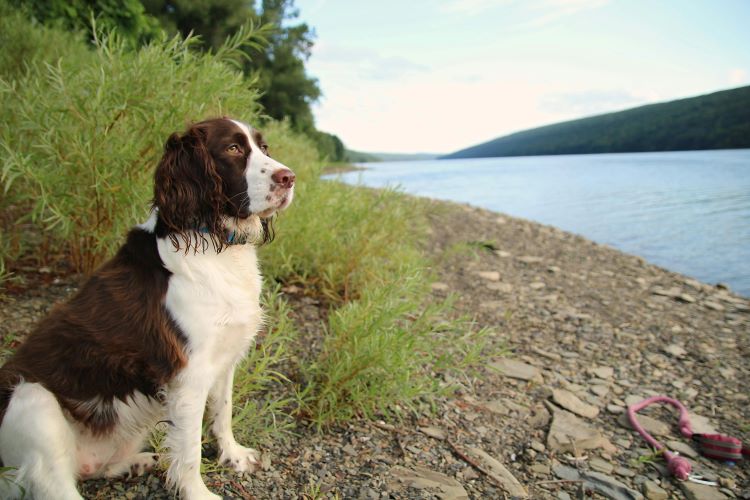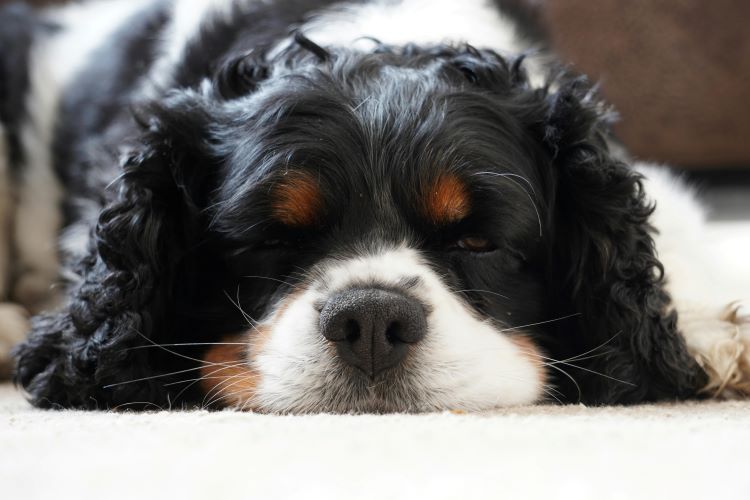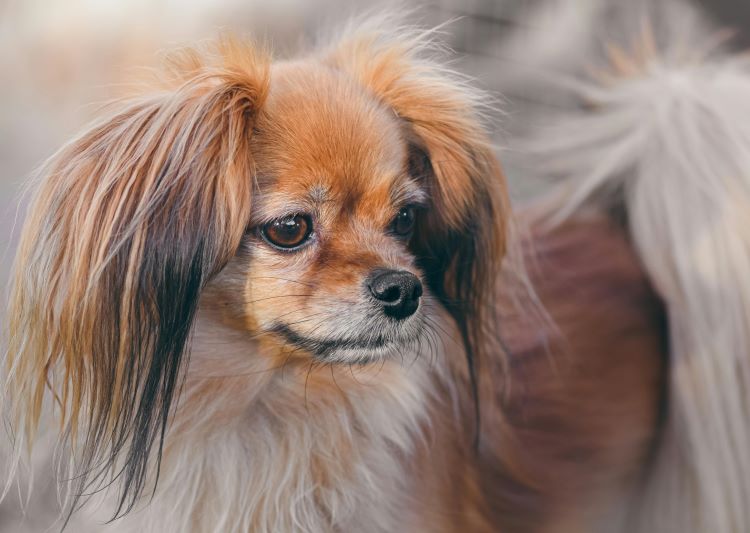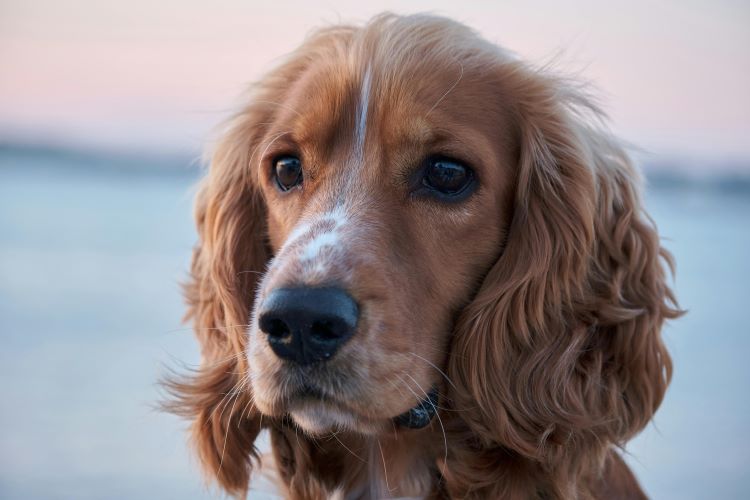Ready to help treat your pet to a healthy life?
What is a Spaniel? Popular Spaniel Breeds Explained
By : Brianna Gunter | Published Feb 18, 2025

Is there a face sweeter than that of a spaniel? Known for being intelligent, highly trainable, and affectionate, spaniels of all varieties make for popular family pets around the world. But speaking of varieties, how many types of spaniels are there? And, while we’re at it, what even is a spaniel-type dog anyway?
Whether you're considering adopting one of these sweet canines or are just exploring the wonderful world of dogs, here’s the scoop on these floppy-eared friends.
What is a spaniel?
A spaniel is not its own breed but rather a group of dog breeds with similar characteristics and history. A type of hunting dog or “gun dog,” the spaniel was bred to help flush out game from dense hiding places and retrieve fowl and other small targets. Though their exact origins are unknown, spaniels date back to at least 14th century Europe, where they were divided into two groups: “water spaniels” and “land spaniels.”
In spite of their shared history, spaniel dog breeds are diverse and come in a wide range of shapes and sizes — there are quite a few types of toy spaniels in addition to standard breeds. Their coloring is diverse, as are their particular coat textures, though spaniels as a whole are often characterized has having long, silky fur trimming their torsos, tails, and ears.
Health considerations
Spaniels are generally healthy dogs, but they can be prone to certain breed-specific health issues. For example, their long, floppy ears can trap moisture, leading to frequent ear infections, so regular cleaning is essential. Many spaniels, especially Cocker and Springer Spaniels, are at risk for hip dysplasia, progressive retinal atrophy (PRA), and heart conditions. Some may also develop obesity if not given enough exercise. Regular vet check-ups, a balanced diet, and plenty of activity help keep them in top shape. Additionally, their lush coats require routine grooming to prevent matting and skin infections.
To keep your spaniel healthy, it’s important to keep up with routine veterinary care in addition to following basic hygiene (like the aforementioned ear cleaning). It’s also a good idea to sign up for dog insurance to help protect against surprise illnesses and accidents.
18 spaniel dog breeds to know
How many types of spaniels are there, you wonder? Well, like many things that have to do with canine breeds, it depends on who you ask. The American Kennel Club recognizes 15 different spaniel-type breeds as of 2025. At the same time, The Kennel Club in the UK recognizes just 12 spaniel breeds. Meanwhile, Spaniel King (a website dedicated entirely to, you guessed it, spaniels) maintains there are 24 different types of spaniel dogs and counting!

Unless you’re planning on bringing your own spaniel to the dog show circuit or enter certain areas of the breeding world, it doesn’t matter if they’re “officially” recognized or not. We also love all canines here at Trupanion’s Pet Parenting. So, just for fun, here’s a list of popular and interesting spaniel-type dog breeds worth knowing:
1. Cavalier King Charles Spaniel
Also known as the CKCS, this is a beloved British spaniel breed that falls into the toy category. Originally bred as a companion dog for members of the royal family, this breed thrives on human interaction and is incredibly friendly, making it a fantastic family pet. Cavaliers are adaptable, equally happy cuddling on the couch or playing outdoors. They tend to get along well with children and other animals, though proper introductions are a must.
2. English Toy Spaniel
A dog breed that closely compares to the Cavalier King Charles is the English Toy Spaniel. Both of these small spaniels were developed in England primarily for companionship. And, at a glance, they may even look the same. Making things even more confusing, the English Toy Spaniel is occasionally referred to as the King Charles Spaniel because it is believed to have been favored by both King Charles I and King Charles II.
Nevertheless, the English Toy is a slightly older breed than the Cavalier, and its temperament is a bit more reserved. The English Toy also has a slightly shorter muzzle and more color variation than its younger counterpart.
2. American Cocker Spaniel
Bred from the English Cocker Spaniel, the American Cocker Spaniel was recognized as its own breed in the mid-20th Century. With a rounded head, short snout, and gorgeous flowing fur, this dog is among the most stylish of spaniels. The ACS suits stylish lifestyles too — affectionate and loyal, this dog is well-known for its cuddles and love of leisure.
Miniature Cocker Spaniels have likewise gained momentum over the past few decades. These petite versions are adorable, but it’s worth noting that they are so far not recognized by any established kennel clubs, and they may come with additional health risks.
4. English Cocker Spaniel
Though it sounds like just a variation of the American Cocker Spaniel, the English Cocker Spaniel or “ECS” is considered its own distinct dog breed. Both, however, are usually just called the Cocker Spaniel, especially in their countries of origin. The English Cocker differs from the American in that it is larger on average and has a longer, less-domed head. It’s also known to be more energetic and driven to learn and please.
Great for the active dog owner, the English Cocker Spaniel has long been one of the most popular dog breeds in the UK.
5. Welsh Springer Spaniel
The Welsh Springer Spaniel goes by many names: Welsh Springer, Welsh Starter, Welshie, and even Welsh Cocker Spaniel. But regardless of what you call it, this rare spaniel breed is a hard-working, loyal pup known for forming close attachments to its humans. This can make them a bit wary of newcomers, but potential issues can be overcome with proper introductions and socialization.
Welshies are also known for their unique look. They come in any pattern of rich, striking red and white. Any other colors in there, and they are likely mixed with another dog breed or may be another type of spaniel entirely.
6. English Springer Spaniel
Though the English Springer and Welsh Springer are often confused, they are (like types of Cocker Spaniels) considered two separate dog breeds. Compared to its Welsh cousin, the English Springer Spaniel is larger in build and is more commonly found in both North America and the UK. They also notably come in more color variation, with liver, black, and tri-color hues being common in addition to red and white.
7. Papillon
Did you know that the Papillon is a type of spaniel? It’s true! Though “spaniel” is not typically used in its name, this friendly small dog breed is actually known as the oldest toy spaniel in existence today. With origins in France, the Papillon has been seen in paintings that go back to the 16th century.
In addition to its small stature, the Papillon is more unique among spaniel breeds with its perky, “butterfly” ears. Both the ears and coat require careful grooming on a regular basis, but the result is a beautiful, energetic pup.

8. Brittany
Commonly referred to as just the Brittany, the Brittany Spaniel is a medium-sized, athletic dog originally from northwestern France. These dogs come in many different coat colors and textures, and their fur can be either straight or wavy. But regardless of what they look like, Brittanys are considered highly trainable and hard-working — they have a long history of success in elite canine competition.
9. Field Spaniel
If you’ve never heard of a Field Spaniel, that’s because it’s on the rare side. Nevertheless, this older breed of spaniel is known for its affectionate personality, intelligence, and beautiful, glossy coat. Originally bred as a hunting companion (in, as you may have guessed, field areas), it has a calm and gentle demeanor, making it an excellent family pet.
Unlike some other spaniel breeds, Field Spaniels are more laid-back but still require regular exercise and mental stimulation. They have long, floppy ears and a water-resistant coat that comes in solid colors like black, liver, or roan, requiring routine grooming.
10. Clumber Spaniel
Seeing a Clumber Spaniel for the first time can be quite the shock. Weighing anywhere from 55 to 85 lbs. (25 to 39 kg) with a noticeably sturdy build, this pup is easily the biggest of all spaniels! Named after Clumber Park, an English estate where it was bred, the Clumber Spaniel is a strong, capable hunting dog albeit a bit slower than other breeds.
11. American Water Spaniel
As its name suggests, the American Water Spaniel was developed in the United States and is known for its curly, water-resistant coat and swimming capabilities. As a result, it excels in waterfowl and upland bird hunting. Highly intelligent and eager to please, American Water Spaniels are trainable but can be independent at times.
While friendly, the AWS can be reserved with strangers. With proper training, exercise, and socialization, they can make loyal, hardworking companions both in nature and at home.
12. Irish Water Spaniel
Another spaniel built for swimming and water retrieving, the Irish Water Spaniel is a rarer dog breed than its American counterpart. But among those who are familiar, this dog is a treasure among canines. Often called the “clown of the spaniel family,” the IWS is beloved for its energy and love of fun. These dogs also have a unique, tightly curled liver coat that adds to its playful appearance. Despite acting goofy at times, they are considered highly trainable with firm and consistent guidance.
13. Boykin Spaniel
Boykins are sometimes called “South Carolina’s best-kept secret,” and with good reason. They’ve been the state dog since 1985, developed there for assistance with hunting Carolina waterfowl and wild turkey. While some still serve this purpose today, they’re better known for their beautiful appearances and high trainability. Boykins come with rich chocolate or liver-colored coats, feathery ears, and webbed feet that make them well-suited for swimming. With their playful, hardworking nature, Boykin Spaniels make fantastic companions for active owners.
14. Russian Spaniel
The Russian Spaniel is a relatively rare breed of spaniel originating from Russia. Developed in the 20th century, this medium-sized dog was bred to work as a cold-hardy hunting companion, particularly for bird hunting and retrieving. The Russian Spaniel has a dense, wavy or curly coat, typically in shades of black, brown, or tan, often with some white markings.
Despite their working origins, Russian Spaniels are friendly, intelligent, and affectionate, making them great family pets. They tend to thrive in active households that can offer them both attention and outdoor adventures.
15. French Spaniel
The French Spaniel or “Epagneul Français” is a medium-sized, versatile hunting dog originating from — you guessed it — France. A breed with a lot of benefits, it is just as well known for its keen hunting skills as it is its gentle, affectionate temperament. This spaniel also has a gorgeous long, wavy coat that is typically white with brown or orange markings. While not overly energetic, the French Spaniel requires regular exercise and mental stimulation to stay happy and healthy.
16. Sussex Spaniel
The Sussex Spaniel is a rarer spaniel breed known for its long, flowing coat, droopy ears, and calm, affectionate personality. Originally bred in the Sussex region of England, this medium-sized pup has a distinctive rich golden-liver coat and a low, sturdy build. This makes many of them appear heavier than other spaniels. They are nevertheless known for their mellow, laid-back temperament, which makes them great companions in a family setting.
17. Picardy Spaniel
It’s also worth noting that a very similar breed, the Blue Picardy Spaniel, also exists and comes from France. However, the Picardy Spaniel is the older of the two. Also known as the “Epagneul Picard,” this medium-sized, versatile French hunting dog is known for its keen nose and friendly, calm temperament. Originating in the Picardy region of northern France, it was bred to work as a retriever in both water and field, excelling in pointing and flushing game. The breed has a distinctive, wavy, water-resistant coat that is typically brown or fawn with darker markings.
18. Tibetan Spaniel
We’ve included it in this list due to its name and common perceptions, but, believe it or not, the Tibetan Spaniel is not actually considered a Spaniel by most kennel club standards. That’s because it isn't a true spaniel in the traditional sense, having been bred as a companion dog in the Himalayan region of Tibet. Tibetan Spaniels are known for their beautiful, silky coat that comes in a variety of colors, as well as their characteristic plumed tail that curls over their back. Similar to traditional spaniels, however, they are intelligent, alert, and courageous, often acting as watchdogs while still being affectionate with their families.

Like learning about different types of canines? Check out our dog breed guide!
